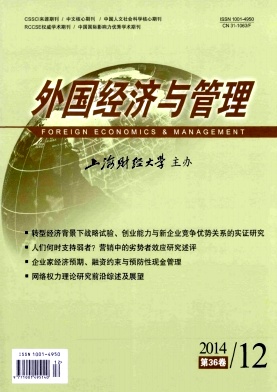网络权力理论研究前沿综述及展望
外国经济与管理 2014 年 第 36 卷第 12 期, 页码:47 - 55
摘要
参考文献
摘要
网络权力是网络交换和协调过程中不同网络节点的控制能力和影响能力。网络权力是影响网络组织的运行绩效和治理效果的重要维度,也是网络治理的重要研究内容之一。本文以网络权力的渊源、度量、决定、应用、影响为主要考察对象,涵盖了从社会网络理论、权力决定理论到企业网络理论、行为影响理论等内容的探讨,最后在现有前沿文献分析的基础上对未来可能的发展趋势进行了展望。
[1]Ahituv N and Carmi N.Measuring the power of information in organizations[J].Human Systems Management,2007,26(4):231-246.
[2]Albino V,et al.Industrial districts as complex adaptive systems:Agent-based model of emergent phenomena[A].Industrial Clusters and Inter-firm Networks[C].Northampton:Edward Elgar Publishing,2005:73-82.
[3]Bonacich P B.Power and centrality:A family of measures[J].American Journal of Sociology,1987,(92):1170-1180.
[4]Brass D J and Burkhardt M E.Potential power and power use:An investigation of structure and behavior[J].Academy of Management Journal,1993,(36):465-490.
[5]Bridge G.Mapping the terrain of time-space compression:Power networks in everyday life[J].Environment and Planning,D:Society and Space,1997,15(5):92-112.
[6]Dicken P.Global shift:Mapping the changing contours of the word economy,5th ed.[M].New York:Guilford,2007.
[7]Emerson R M.Exchange theory:A psychological basis for sociological exchange[A].Berger J,et al(eds.).Sociological Theories in Progress[C].Houghton-Mifflin,1972:121-143.
[8]Foucault M.Power:The essential works of Michel Foucault 1954-1984[M].Volume Two.London:Allen lane,2000.
[9]Freeman L C,et al.On human social intelligence[J].Journal of Social and Biological Structures,1988,(11):950-979.
[10]Gereffi G.Global commodity chains:New forms of coordination and control among nations and firms in international industries[J].Competition and Change,1996,(1):427-439.
[11]Giddens A.The third way:The renewal of social democracy[M].Cambridge:Polity,1998.
[12]Granovetter M.Economic action and social structure:The problem of embeddedness[J].American Journal of Sociology,1985,(91):62-76.
[13]Granovetter M.The impact of social structure on economic outcomes[J].Journal of Economic Perspectives,2005,19:33-50.
[14]Hall S G and Petroulas P.Spatial interdependencies of FDI locations:A lessening of the tyranny of distance?[R].Discussion Papers in Economics,2008.
[15]Harrison B.Industrial districts:Old wine in new bottles[J].Regional Studies,1992,(26):469-483.
[16]Hayek F A.The use of knowledge in society[J].American Economic Review,ⅩⅩⅩⅤ,September,1945,4:519-530.
[17]Hingley M.Power imbalanced relationships:Cases from UK fresh food supply[J].International Journal of Retail&Distribution Management,2005,33(8):487-514.
[18]Kahkonen A.The influence of power position on the depth of collaboration[J].Supply Chain Management:An International Journal,2014,19(1):17-30.
[19]Krackhardt D.Assessing the political landscape:Structure,cognition,and power in organizations[J].Administrative Science Quarterly,1990,(35):342-369.
[20]Limerick D.The shape of new organization:Implications for human resource management[J].Asia Pacific Journal of Human Resources,1992,30(1):38-52.
[21]Ma D,et al.Power source mismatch and the effectiveness of interorganizational relations:The case of venture capital syndication[J].Academy of Management Journal,2013,56(3):711-734.
[22]Maloni M and Benton W C.Power influence in the supply chain[J].Journal of Business Logistics,2000,21(1):49-73.
[23]Markovsky B.Network exchange outcomes:Limits of predictability[J].Social Networks,1992,14(3-4).
[24]Martin R.Institutional approaches in economic geography[A].Sheppard E and Barnes T(eds.).A Companion to Economic Geography[C].Blackwell Publishing,2000:75-92.
[25]Parsons M D.Power and powerlessness in industry:An analysis of the social relations of production[J].Labor Studies Journal,1988,13(3):231-256.
[26]Smith A.Power relations,industrial clusters,and regional transformations:Pan-european integration and outward processing in the Slovak clothing industry[J].Economic Geography,2003,79(1):17-40.
[27]Sozen H C.Social networks and power in organizations:A research on the roles and positions of the junior level secretaries in an organizational network[J].Personnel Review,2012,41(4):487-512.
[28]Turker D.Analyzing relational sources of power at the interorganizational communication system[J].European ManagementJournal,2014,32(3):509-517.
[29]Yamagishi T,et al.Network connections and the distribution of power in exchange networks[J].American Journal of Sociology,1988,(93):2103-2127.
①Bonacich认为,矩阵的最大特征值对应的特征向量能得到一个好的网络中心度。
②Bonacich注意到,如果一个节点与高中心度的节点相连,该节点的中心度也会提高,并提高与自己相连的其他节点的中心度。
①技术权力是网络权力的一种,是网络结构非均衡性的体现。此概念由曾刚于2008年提出,其后张云逸(2009)进行了拓展。
[2]Albino V,et al.Industrial districts as complex adaptive systems:Agent-based model of emergent phenomena[A].Industrial Clusters and Inter-firm Networks[C].Northampton:Edward Elgar Publishing,2005:73-82.
[3]Bonacich P B.Power and centrality:A family of measures[J].American Journal of Sociology,1987,(92):1170-1180.
[4]Brass D J and Burkhardt M E.Potential power and power use:An investigation of structure and behavior[J].Academy of Management Journal,1993,(36):465-490.
[5]Bridge G.Mapping the terrain of time-space compression:Power networks in everyday life[J].Environment and Planning,D:Society and Space,1997,15(5):92-112.
[6]Dicken P.Global shift:Mapping the changing contours of the word economy,5th ed.[M].New York:Guilford,2007.
[7]Emerson R M.Exchange theory:A psychological basis for sociological exchange[A].Berger J,et al(eds.).Sociological Theories in Progress[C].Houghton-Mifflin,1972:121-143.
[8]Foucault M.Power:The essential works of Michel Foucault 1954-1984[M].Volume Two.London:Allen lane,2000.
[9]Freeman L C,et al.On human social intelligence[J].Journal of Social and Biological Structures,1988,(11):950-979.
[10]Gereffi G.Global commodity chains:New forms of coordination and control among nations and firms in international industries[J].Competition and Change,1996,(1):427-439.
[11]Giddens A.The third way:The renewal of social democracy[M].Cambridge:Polity,1998.
[12]Granovetter M.Economic action and social structure:The problem of embeddedness[J].American Journal of Sociology,1985,(91):62-76.
[13]Granovetter M.The impact of social structure on economic outcomes[J].Journal of Economic Perspectives,2005,19:33-50.
[14]Hall S G and Petroulas P.Spatial interdependencies of FDI locations:A lessening of the tyranny of distance?[R].Discussion Papers in Economics,2008.
[15]Harrison B.Industrial districts:Old wine in new bottles[J].Regional Studies,1992,(26):469-483.
[16]Hayek F A.The use of knowledge in society[J].American Economic Review,ⅩⅩⅩⅤ,September,1945,4:519-530.
[17]Hingley M.Power imbalanced relationships:Cases from UK fresh food supply[J].International Journal of Retail&Distribution Management,2005,33(8):487-514.
[18]Kahkonen A.The influence of power position on the depth of collaboration[J].Supply Chain Management:An International Journal,2014,19(1):17-30.
[19]Krackhardt D.Assessing the political landscape:Structure,cognition,and power in organizations[J].Administrative Science Quarterly,1990,(35):342-369.
[20]Limerick D.The shape of new organization:Implications for human resource management[J].Asia Pacific Journal of Human Resources,1992,30(1):38-52.
[21]Ma D,et al.Power source mismatch and the effectiveness of interorganizational relations:The case of venture capital syndication[J].Academy of Management Journal,2013,56(3):711-734.
[22]Maloni M and Benton W C.Power influence in the supply chain[J].Journal of Business Logistics,2000,21(1):49-73.
[23]Markovsky B.Network exchange outcomes:Limits of predictability[J].Social Networks,1992,14(3-4).
[24]Martin R.Institutional approaches in economic geography[A].Sheppard E and Barnes T(eds.).A Companion to Economic Geography[C].Blackwell Publishing,2000:75-92.
[25]Parsons M D.Power and powerlessness in industry:An analysis of the social relations of production[J].Labor Studies Journal,1988,13(3):231-256.
[26]Smith A.Power relations,industrial clusters,and regional transformations:Pan-european integration and outward processing in the Slovak clothing industry[J].Economic Geography,2003,79(1):17-40.
[27]Sozen H C.Social networks and power in organizations:A research on the roles and positions of the junior level secretaries in an organizational network[J].Personnel Review,2012,41(4):487-512.
[28]Turker D.Analyzing relational sources of power at the interorganizational communication system[J].European ManagementJournal,2014,32(3):509-517.
[29]Yamagishi T,et al.Network connections and the distribution of power in exchange networks[J].American Journal of Sociology,1988,(93):2103-2127.
①Bonacich认为,矩阵的最大特征值对应的特征向量能得到一个好的网络中心度。
②Bonacich注意到,如果一个节点与高中心度的节点相连,该节点的中心度也会提高,并提高与自己相连的其他节点的中心度。
①技术权力是网络权力的一种,是网络结构非均衡性的体现。此概念由曾刚于2008年提出,其后张云逸(2009)进行了拓展。
引用本文
孙国强, 张宝建, 徐俪凤. 网络权力理论研究前沿综述及展望[J]. 外国经济与管理, 2014, 36(12): 47–55.
导出参考文献,格式为:





 7798
7798  280
280

